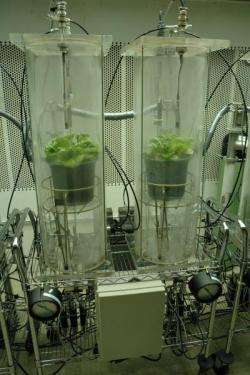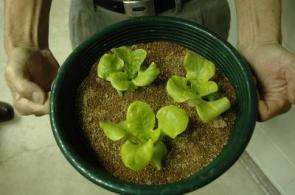Galaxy gardening more than hobby for future moon, Mars residents

Long periods of total darkness and poor soil needn't stop an avid gardener – at least not one who's willing to go out of this world to grow plants. Lush lettuce is growing by galactic measure in cylinders designed by Texas Agricultural Experiment Station researchers to mimic conditions on the moon and Mars.
"We're to the point now that we are confident with the systems we have developed, though it may not ultimately look like this (lab model)," said Dr. Fred Davies, Texas Agricultural Experiment Station horticulturist.
The research, part of the National Air and Space Administration's "Salad Bowl" project, is unique in that university-based scientists are tasked with finding a way to produce food in spatial conditions unparalleled on Earth.
Two certainties make this work important, the researchers believe: Humans will continue to explore uncharted expanses of the universe, and where humans go, food is a must.
"Exploration is part of our blood. Ultimately, we will start to inhabit on lunar and Martian surfaces in the near future," Davies said.
For now, food is transported in shuttles in quantities to last a space trip. Food also is taken to the International Space Station for the three people who work there in six-month stints.

Astronaut fare has gone from "bite-sized foods suitable for eating with one's fingers, and pureed foods, squeezed directly into the mouth from flexible metal toothpaste-type tubes" to some 200 different menu selections now including fresh tortillas and chicken fajita meat served on more appealing food trays, according to NASA food nutritionists.
But ultimately, for people to live in space for longer periods, self-sustaining food production would be vital, Davies noted.
Enter agriculture. The age-old profession is much on the minds of space exploration scientists.
Davies said green produce in space has both nutritional and psychological benefits. While leafy lettuce may provide humans with essential nutrients such as vitamin A, it also provides a welcomed fresh texture for astronauts who quickly get their fill of reconstituted food.
"A part that is important is the psychology of eating something that is green, smells like something you are used to on Earth, that has some texture to it and some freshness," Davies said.
Developing equipment to hurl humans into space has been less a challenge for engineers than finding ways to grow food. Mainly, all the earthly conditions that make plants thrive either don't exist or are vastly different in space.
The moon, for example, has no atmospheric pressure (vital for the development of clouds and rainfall) and only one-sixth the gravity of Earth. Its days, or period of light, last the equivalent of about a month on Earth and are followed by the equivalent of two weeks of darkness, Davies pointed out. And it has no carbon, which is essential for photosynthesis.
Mars, on the other hand, has an atmosphere that is about 95 percent carbon dioxide and an atmospheric pressure one-hundredth that of Earth's. And while a Martian day is a little longer than earth's 24-hour period, there is less available light for plant growth, the researcher noted.
To figure out how to grow plants in space, scientists first had to toss out what is known about plant production. They also had to design, build and operate growing chambers to work under space-like conditions. That meant developing chambers that would work in low pressure and provide plants with what's needed to photosynthesize, or grow and yield adequate quantities of food.
Thus far, their research has shown that the plants are doing better in the low-pressure conditions.
"The advantage to low pressure means we have to have less materials which means less cost," said Dr. Ron Lacey, Experiment Station agricultural engineer. "But to create a system for plants to grow in low pressure is very challenging."
Lacey said previous research on such systems had numerous issues with leakage – perhaps leaking the whole volume of air in a day.
"But we were able to create a very tight system that only leak about 1.5 percent of its volume per day or less," Lacey said, "and we see some very interesting things going on (with plant growth)."
"We have found that the plants grow better in the low pressure, and also that the gas ethylene has a big effect on plant growth," said Dr. Chuan He, Experiment Station researcher who plants, harvests and analyzes the lettuce for quality. Plants under low pressure produce less ethylene and use-up less carbohydrates at night (lower dark-period respiration), which produces larger heads of lettuce.
He, who said tending plants on Mars is his wished-for occupation, has sampled the product of his labors.
"The lettuce actually tastes quite good," He said.
Davies noted that plants also are useful for producing oxygen and reducing carbon dioxide, both important factors for humans.
"It may be that these plants are grown below ground in special growth chambers on Mars and the moon," Davies said. "They are looking at ways to be able to catch and store light on the moon and then be able to use that light later on."
Source: Texas A&M University - Agricultural Communications





















